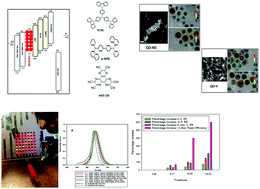High efficiency and highly saturated red emitting inverted quantum dot devices (QLEDs): optimisation of their efficiencies with low temperature annealed sol–gel derived ZnO as the electron transporter and a novel high mobility hole transporter and thermal annealing of the devices
Abstract
Quantum dot light emitting diodes (QLEDs) are promising candidates for high efficiency and high colour gamut displays with saturated colours. This paper reports a peak current efficiency of 46 cd A−1 and a peak power efficiency 42 lm W−1 for red QLEDs with CIE (x, y) of (0.695 and 0.305), which we believe to be the highest ever reported for a red QLED. Annealing QLED devices at 40 °C for 120 hours makes such a dramatic increase in the peak current efficiency by 207% (from 15 cd A−1 to 46 cd A−1) and the power efficiency by 600% (from 6 lm W−1 to 42 lm W−1). This paper also addresses three major issues confronting the development of QLEDs: first, the nature of CdSe based QDs, whether a sulphur rich (CdSe (core)/CdS (shell)/ZnS (shell)) or selenium rich (CdSe (core)/ZnSe (shell)/ZnS (shell)) system gives higher efficiency; secondly, how to balance the charge injection from high electron mobility ZnO films by simply altering the annealing conditions rather than the complicated application of thin insulating interfacial layers (2–5 nm); and thirdly, improving the hole injection using high mobility hole transporters (electron blockers). In addition, this paper also investigates the effect of annealing the encapsulated devices (positive aging) on the device performance. The (CdSe (core)/CdS (shell)/ZnS (shell)) QD films dried at 80 °C have a hole mobility of 3.1 × 10−7 cm2 V−1 s−1 and an electron mobility of 6.7 × 10−8 cm2 V−1 s−1, whereas the corresponding values for (CdSe (core)/ZnSe (shell)/ZnS (shell)) are 2.0 × 10−6 cm2 V−1 s−1 and 1.1 × 10−6 cm2 V−1 s−1. The electron transport in all the QLEDs has been found to be space charge limited regardless of the QDs employed. Annealing sol–gel derived ZnO nanoparticles at 120 °C in a vacuum results in films (particle size 3–5 nm, crystallinity 60.7%) with an electron mobility of 3 × 10−5 cm2 V−1 s−1, which is compatible with standard low mobility organic hole injectors and electron blockers to yield high efficiency devices. ZnO films annealed at 200 °C in air (crystallinity 90.2%, mobility 1.1 × 10−4 cm2 V−1 s−1) results in poorer efficiency for an identical device structure. The work function and band gap of the ZnO (vacuum annealed at 120 °C) films are −3.9 eV and 3.5 eV respectively. The corresponding values for the ZnO (annealed at 200 °C in air) films are −3.8 and −3.3 eV respectively. Despite these small differences, there is a significant impact on the device performance, which is attributed to the differences in the mobilities of the ZnO films and ZnO/QD interfacial effects. The (CdSe/ZnSe/ZnS) QDs give higher efficiencies (16 cd A−1 and 10 lm W−1 at 1000 cd m−2) than the analogous (CdSe/CdS/ZnS) system (10 cd A−1 and 5.8 lm W−1 at 1000 cd m−2). Upon annealing at 40 °C for 120 hours, the latter system gives enhanced efficiencies of 26 cd A−1 and 12.5 lm W−1 at 1000 cd m−2. High mobility, high LUMO hole transporters/electron blockers are essential for the production of high efficiency QLEDs with saturated colour CIE co-ordinates of (0.708, 0.292).



 Please wait while we load your content...
Please wait while we load your content...